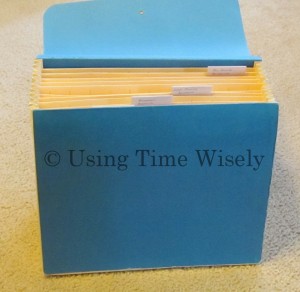 For only having 5 categories in File Box 3, I feel like it is taking so long to progress through this file box which is partly due to the interruptions in December and January. In spite of the delays, we will complete the investment documents category today. 🙂
For only having 5 categories in File Box 3, I feel like it is taking so long to progress through this file box which is partly due to the interruptions in December and January. In spite of the delays, we will complete the investment documents category today. 🙂
The following is a recap of the documents housed within the two file openings of our accordion filing box holding our investment documents:
Fourth File Slot
- Cash accounts – with free printable record
Fifth File Slot
- Closed bank account letters
Closed Bank Account Letters
When I was organizing our important documents, this category never crossed my mind. In her Protection Portfolio, Suze Orman designates a slot for closed bank accounts.
In thinking through all the financial institutions where I held accounts, I had assumed the accounts were closed when I withdrew all the money. However, I did not have letters confirming those accounts were closed.
Requesting Closed Bank Account Letters
This process took some time as I contacted each financial institution for both Paul and I. Together we had 8 accounts with some of them banks and others credit unions. Then I took the following steps:
1. Located the account numbers for each financial institution (e.g., consulted checks, bank statements, and correspondence),
2. Contacted each financial institution,
3. Verified that our account was closed,
4. Requested a letter stating the account was closed by consumer,
5. Received the letter via mail, fax, or e-mail, and
6. Filed the closed bank account letters within our file box 3.
Obstacles Gaining Closed Bank Account Letters
Though it sounds easy to just contact the company, I did run into these obstacles along way:
1. Account information had been purged from the financial institution
After a few rounds of trying to get a letter, I finally spoke to a vice president at the main branch who sent a letter stating that we no longer had any open accounts and included our social security numbers as the account numbers could not be verified.
2. Needed our request in writing
Upon calling some of our financial institutions, they required our request in writing. I composed a letter and mailed it to the bank or credit union. I chose not to fax as our social security numbers were on the document, and I did not know who had access to the fax machine.
FREEBIE: Should you need to provide a written request, you may use the following sample letter to make your inquiry:
Free printable Bank Account Closing Letter – WORD document format
3. Financial institution had a merger after the account was closed
For these accounts, the current financial institution did not have records from the previous bank. So, they provided a letter indicating the original account numbers from the previous bank and the new account numbers had been closed and, in one case, purged from their system.
4. No records found for the account numbers
One institution could not find any information, so they provided a letter stating that they were unable to locate any records.
Having the verification that all non-used accounts are closed, we know where our money rests. We also have confirmation that our other accounts are closed should an unauthorized transaction take place. The letters provide proof that the financial institution closed our account or has no open accounts with our names or social security numbers.
Weekly Project: Gather your closed bank account letters or contact financial institutions to receive closed bank account letters.
In organizing your important documents, you might find this step time-consuming. As I did not have any of these letters when I started organizing my file, I invested my time calling and writing to get this information. Now, I know that all our accounts are current with no outstanding fees or monies at other banks or credit unions.
This post brings our third category to a close. You have some time to work on this step as I will begin the fourth category in May. For April, I will try another month of themed posts. Look for more details in this Wednesday’s post.
Keep making progress. In using time wisely, your investment of time and energy will let you know exactly where your investments lie. Little by little your filing system is coming together. You are in the homestretch with only two more categories to go. Happy organizing!
Question: Do you typically request a closed bank account letter when changing financial institutions?